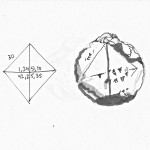
Four millennia ago in northern Mesopotamia, archeologists speculate, a young Babylonian was practicing geometry. One problem required finding the length of the diagonal of a square. Taking his circular tablet of damp clay in one hand and his favorite reed in the other, he copied down the exercise, sketching out a diagram of a square with a few hasty strokes. He wrote the square root of two along one diagonal, multiplied by the side length, and scrawled the solution across the clay.
Having lain in the sand for a little under four thousand years, his discarded assignment is now part of the Yale Babylonian Collection: the oldest extant record of an approximation of the square root of two. The young scribe’s work became the centerpiece of “Before Pythagoras: The Culture of Old Babylonian Mathematics,” a recent exhibit at the Institute for the Study of the Ancient World at New York University.
The student may have been just applying a formula he learned in school. There’s no proof he understood why multiplying a side length by root two gave the length of the diagonal. But his tablet is evidence that mathematicians in the Old Babylonian Period (2000-1600 B.C.E.) knew what we call the Pythagorean Theorem more than a millennium before Pythagoras taught in Athens. The approximation this Babylonian scribe used differs from the actual value of root two by only 0.0000006.
The exercise is “particularly cute,” says Duncan Melville, a professor of the history of mathematics at St. Lawrence University. “It’s particularly easy.” That is, if you can read cuneiform base-60 notation. (Babylonian 11 is our 61; 111 is 3661. The Babylonians also used this system for astronomical calculations, which is why we still have 60 seconds in a minute and 3,600 in an hour. When historians translate Babylonian numbers, they separate each digit with commas to avoid confusion, so that 1,10 is 70, just as 1:10 a.m. is 70 minutes past midnight.)
With such a complicated numerical system, learning your times tables took dedication. The largest tablet on display at ISAW, also part of Yale’s collection, was a multiplication table, about 10” x 8”. “We think they learned them all,” says Melville. “There was a set of 40 multiplication tables you had to learn, and you practiced them. People in the ancient Near East had what seem to us prodigious memories.”
The multiplication tables, in short, were of epic length. And if the system Babylonian mathematicians used to calculate square roots was as unwieldy as the 480-pound sword Gilgamesh used to slay Humbaba, it was also just as effective.
To divide, they multiplied by reciprocals. Melville calls this exercise “cute” because the side of the square on this tablet is 30 units long. That’s Babylonian for one-half—they had no equivalent of a decimal point—so when you multiply the side by root two, the length of the diagonal is just the reciprocal of root two. See how that comes out? Easy.
The exhibit at ISAW received an enthusiastic response. The museum had planned to close the exhibit on December 17, but, due to demand, it was extended another month. CNN and The New York Times both interviewed Melville about it. Alice Slotsky, a colleague of Melville’s who lives in Providence, Rhode Island, told me, “A lot of people do Babylonian astronomy. Not many do math and do it correctly. As far as I’m concerned, he’s the master.”
“It’s great,” Melville told me. “It’s an obscure field that’s not on people’s radar very often.”
Melissa Dallal and Tracy White visited the exhibit for Dallal’s birthday. Dallal’s parents, she said, are Jews from northern Iraq, so she’s taken an interest in Babylonian history. “It just makes me wish I understood math to begin with,” White told me.
NYU Provost David McLaughlin was also curious to see the exhibit. “It’s striking, the age of the materials,” he said to me. “I didn’t appreciate how much math was known then.”
Babylonian math looks very familiar. A multipart word problem from one tablet suggests a pre-algebra textbook from a Babylonian junior high school: “A canal’s length is five us, its width is three cubits, its depth is 3 cubits. A worker’s daily load of earth is 10 gin. A worker’s daily wages are 6 se of silver. What is the canal’s surface area, its volume, the number of workers needed to dig it, and the total cost in silver?”
Other tablets involve more theoretical math. One is a list of Pythagorean triples—the lengths of sides of various right triangles. Others list problems that the ancient Babylonians lacked the techniques to solve—evidence of mathematical research.
“The abstraction of the concept of number, that takes a long time to develop,” said Melville. There are centuries between adding goats and cattle in the sand and approximating quadratic roots. Because the Babylonians used clay, historians can chart the development of their mathematical system from everyday arithmetic to the most theoretical exercises, explained Melville. Other societies’ writing materials—papyrus, for example—have decayed over the centuries.
“What you see on a social level is very similar to what you see with children: dealing concretely with blocks and bricks and things, moving gradually to manipulating abstract numbers,” he added.
The numbers themselves, though, have not changed meaning since Babylonian times. Root two means exactly the same thing today as it did to the young man who wrote it down. So while Yale’s tablet is nothing more than a rough diagram of a square and a few numbers scribbled in cuneiform, it offers an unobstructed view into an ancient mind. It can be difficult to imagine what life must have been like for the Babylonians, but it isn’t hard to look at the square root of two on that crumbling piece of clay and imagine holding the tablet, its grooves still crisp, its base slightly warm from the palm of a classmate’s hand.


